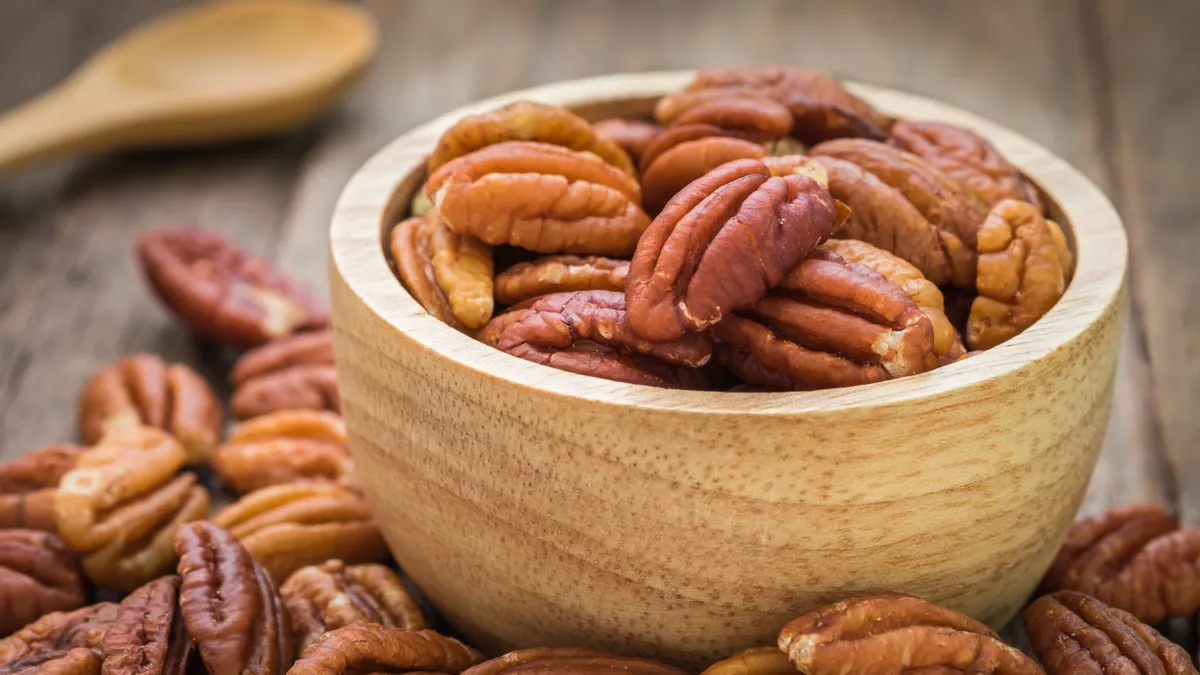Pecans are joining other nuts such as pistachios that are surging in popularity. The supply is projected to grow, potentially doubling by 2027, according to the American Pecan Council.
In the last decade, product introductions featuring pecans have increased by 54% and line extensions featuring the nut have gone up by 141%, according to the American Pecan Promotion Board.
“It’s a bit of a triple play: Flavor, health, and sustainability. Consumers appreciate the flavor profile with its distinct buttery notes. The health benefits are also well received with its antioxidants, vitamins, as well as good macros for a nut,” Sophia Bischof, technical sales manager at chocolate supplier Barry Callebaut. “Lastly, pecans are grown in the southern U.S., and [it is] a reliable crop that is quite resistant to extreme weather.”
The U.S. currently produces 80% of the world’s pecan crops. There are more than 1,000 varieties.
Some cultures are growing more pecans to correct dietary imbalances, according to a 2023 study from Frontiers in Soil Science.
“Pecans are not only rich in iron but also in other micronutrients; thus, the increase in pecan production for domestic consumption would help to improve such indicators,” researchers said.
The rise of the pecan began in 2010, when the market in China began to boom, leading to increased prices for growers and an acceleration in planting by existing and new producers, according to Lenny Wells, a professor and pecan extension specialist at the University of Georgia’s Tifton campus.
Discoveries about its health benefits pushed producers to use pecans as a snack food rather than just in desserts and pies, resulting in a 36% increase in domestic consumption between 2016 and 2021, according to American Pecans.
Increased snacking behaviors since the pandemic also contributed to the rise of the nut, a healthy alternative to processed foods, according to Wells.
Growth in global markets
Those hoping to expand pecan-based products might face some turmoil, though. Pecan prices have not recovered since tariff issues arose with China in 2018, Wells said.
“This, along with COVID and the huge influx of nuts from Mexico into the U.S., have severely cut the price that growers receive for their product,” he added. “At the same time, input costs have risen dramatically, putting enormous downward pressure on profit potential for producers.”
However, there is still potential for growth both domestically and abroad. In the U.S., there are “large swaths of the country that have never really seen or tasted a fresh pecan or even know what a pecan is,” said Wells.
He pointed to the European Union, India and the Middle East as places with the greatest potential for market growth overseas.
Chris Durso, a marketing manager at Cibo Vita/Nature's Garden brand in New Jersey, works with their research and development team on new products and flavor profile development.
“Pecans appear to be gaining popularity thanks, in part, to their high magnesium content — a mineral that has also seen increased popularity with the rise of electrolyte supplementation,” Durso said. Our “team is constantly working on new flavor profiles and products. We’ve found pecans to be versatile and receptive to a lot of applications, from savory to sweet.”











